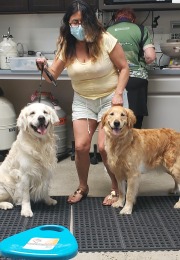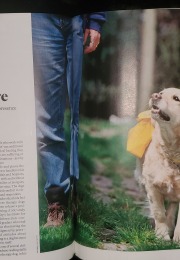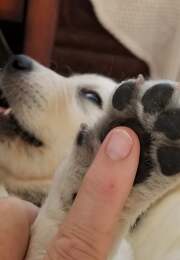Category: “Uncategorized”
Summer Puppies are here!
So excited to have our summer puppies arriving. We have some real beauties up.. and coming. From our second breeding with Jazmin we have 10 Beautiful 3/4 English, 1/4 American. She is a beautiful Golden with Good OFA’s and a wonderfully low COI (no inbreeding here). The pups will be service dog quality, perfect family pets as well! They are located in riverside. Our next litter of English Creams are due in September. I’ll keep you posted! Get on the list ASAP! They go fast!
adoption application 2020
text michelle 909-336-8795 or email mikkimoe@verizon.net
Why Shilos Arctic Star
Puppies up and Puppies Coming
Health and wellness
Training and Socialization
Shilos Contact Information
Dogs Rock and Summer puppies on the Way…Yippi Yippi Yeah
Have you all noticed how Dogs are becoming so much more important as we move thru this pandemic? So much more time at home with your special fur friends and they are key for depression, they can make your blues go away.
Did you know that Life magazine dedicated their entire July issue to dogs! A golden on the cover! It’s amazing!
So to add to all this good news we have summer litters on their way. So just fill out this adoption application 2020 and email it to mikkimoe@verizon.net or text Michelle at 909-336-8795
ShilosArcticStar.com fun links
Why Shilos Arctic Star
Puppies up and Puppies Coming
Health and wellness
Training and Socialization
Shilos Contact Information
Congratulations My Precious Nutmeg!
Seven amazing Shilo and Nutmeg Golden RTertriever Pupspups just in time for all your summer fun. The best thing about this litter is their amazing Low COI from an American Golden and pure English Golden cross – which means zero inbreeding and long healthy lives. AKC and all OFA’s plus warranty on these precious ones. The unique personalities are also a sought after plus for not only service dogs but for family pets. These beauties will go fast get your reservations in today!
Please complete this Application (Click here) and send to Michelle: mikkimoe@verizon.net 909-336-8795
Also in order to keep you and your pets in tip top shape please – pretty please follow Shilos Health and Nutrition Formula – our top class natural food and supplements delivered right to your door! The immune boosters, pre and probiotics as well as complete spectrum of vitamin and mineral supplemented food and treats are the absolute best on the market. just ask any of Shilos 500 puppies! See Shilos Guide to perfect health.
Why Shilos Arctic Star
Puppies up and Puppies Coming
Health and wellness
Training and Socialization
Shilos Contact Information
Holistic Care and Guidance
Please scroll down this page to find information on the following subjects
Grounding
Titer Test Verses Vaccine
To Spay, Nueter or Steralize
Essential Oils
Grounding! All Animals Instinctively Do This if Possible — Do You Give Yours the Chance?
By Dr. Karen Shaw Becker
Previous
Story at-a-glance
- Domesticated dogs and cats today suffer from many degenerative diseases not seen in their wild counterparts; one of the reasons could be that animals in the wild are naturally grounded to the earth
- Grounding — walking barefoot outside or sitting, working or sleeping indoors on a grounding mats — provides benefits such as better sleep and reduced pain
- Research also shows grounding reduces inflammation and improves circulation
- The best way to ground yourself and your pet is to spend time outdoors with your bare feet and your pet’s paws in direct contact with the earth
- If your pet can’t get outside regularly, consider using grounding mats indoors for improved health for both human and furry family members
If you’re a pet parent, you know our furry family members suffer from many of the same degenerative conditions that affect humans. Interestingly, dogs and cats in the wild don’t tend to suffer from those conditions, and one of the reasons, in my opinion, is that wild animals are naturally grounded because they live outside.
They’re in constant contact with the ground, unlike the animals that live with us in our homes, who often don’t have the benefit of regularly making direct contact with the earth.
So What, Exactly, Is Grounding?
If you’ve never heard of grounding, or earthing as it’s also often referred to, or you aren’t sure exactly what the term means, here’s a good description from an article published in the Journal of Environmental and Public Health titled “Earthing: Health Implications of Reconnecting the Human Body to the Earth’s Surface Electrons:”
“Emerging scientific research has revealed a surprisingly positive and overlooked environmental factor on health: direct physical contact with the vast supply of electrons on the surface of the Earth.
Modern lifestyle separates humans [and animals] from such contact. The research suggests that this disconnect may be a major contributor to physiological dysfunction and unwellness. Reconnection with the Earth’s electrons has been found to promote intriguing physiological changes and subjective reports of well-being.
Earthing (or grounding) refers to the discovery of benefits — including better sleep and reduced pain — from walking barefoot outside or sitting, working, or sleeping indoors connected to conductive systems that transfer the Earth’s electrons from the ground into the body.”1
The earth is a natural antidote for electron deficiency and can provide animals with an infinite flow of electrons through grounding, or making direct contact with the earth.
Studies Point to the Significant Health Benefits of Grounding
A few years ago I did a really interesting interview with Clint Ober for Healthy Pets. Clint has spent a lot of time researching how the earth’s electrical energy influences health. He also spent over 30 years in the cable TV industry, grounding equipment to the earth to maintain the electrical stability of the system.
In our interview, Clint explained that when we are grounded, the body is conductive, but when we put shoes on, we lose that conductivity. He grew curious about whether the loss of contact with the earth was having an effect on human health. Clint started experimenting with a voltmeter that he rigged to ground himself while he slept. He discovered he not only slept better, but also noticed that within a few days of sleeping grounded, the chronic pain he lived with began to subside.
Next, Clint decided to design a grounding study involving 60 volunteers. He developed “grounding planes,” which were small pads the volunteers slept on. By the end of the study, for the most part the participants reported sleeping better, feeling better, having more energy and experiencing general improvement in their overall health.
Clint’s anecdotal study attracted the attention of a retired anesthesiologist in San Diego. He and Clint designed another study in which they measured the circadian cortisol levels of a group of volunteers every four hours for 24 hours before grounding. Then they grounded the group for six to eight weeks and took cortisol measurements again on the same schedule at the end of the study. What they found was very interesting.
Before grounding, the volunteers’ cortisol levels were all over the place. But by the end of the study, all the 24-hour circadian profiles were synchronized. The volunteers didn’t know each other and didn’t live close to one another. This result gave Clint a good indication that grounding affects the stress hormone cortisol.
In a subsequent study, Clint worked with an expert in electrophysiology and biofeedback, and they measured the normal biofeedback parameters in a group of 60 individuals. From that study, Clint learned that as soon as the body is grounded, it automatically shifts from a sympathetic state to a parasympathetic state, which means it goes from a fight-or-flight condition to a calm, more relaxed physiologic state.
How Grounding Works
During grounding of a human or animal, the charge is removed from the body. For example, when an indoor-only kitty lives 24/7 above the surface of the earth, let’s say, in a high-rise in downtown Chicago, she can’t benefit from the negative surface charge of the earth that provides an abundance of electrons that move very quickly to reduce the charge on her body. Her body begins to deplete itself of electrons.
By grounding the body, we’re able to gather free electrons from the earth that have the ability to combat free radicals. This is especially important for animals that are constantly bombarded by electromagnetic fields (EMFs) inside the home coming from sources such as wireless routers, appliances and electronics.
It’s like pouring water on a fire. Fire is oxidation. When we connect the body to the earth and the result is a reduction in pain, it’s because we’re flooding the body with electrons. These free electrons can readily absorb and reduce free radicals and prevent them from oxidizing healthy cells.
Grounding Reduces Inflammation and Improves Circulation
Many medical experts suspect all disease is caused by chronic inflammation over an extended period of time. We certainly know in the animal kingdom that’s true. Most chronic diseases have their roots in a chronic low-grade inflammatory process. Disease manifests differently in different bodies, of course, based on a multitude of factors including genetics, environment and lifestyle. But the underlying common thread is chronic inflammation.
According to Clint, a contributing factor to chronic inflammation is a lack of grounding. In a study of young athletes, it was determined that inflammation doesn’t manifest in grounded bodies to the degree that it does in ungrounded bodies. Another study investigated how grounding improves circulation. The study confirmed that red blood cells also equalize with the earth. They take on a negative surface charge.
An example would be if you were to take little magnets and put the negative ends together, they would naturally repel each other. But if you use the positive and negative ends, they pull toward each other. Clint was able to prove, after about 15 years of research and a dozen peer-reviewed published studies, that grounding or earthing absolutely, positively affects physiology.
When we disconnect from the earth, our blood gets sticky and doesn’t function properly. Sticky blood can’t get into the capillaries. It can’t oxygenate tissues. Clint believes this is another underlying cause of chronic inflammation.
As Clint pointed out in our interview, in 1960, 90 percent of visits to general practitioners were for acute injury, infectious disease and childbirth. Today, a whopping 95 percent of all visits are for stress-related or lifestyle-induced disorders, meaning something is interfering with the body’s ability to maintain normal health or balance.
This is true with pets as well. Fifty years ago, vets were seeing patients primarily for acute injuries and infectious diseases. But these days most patients we see are suffering with chronic degenerative diseases. It’s an epidemic.
The Best Way to Ground Yourself and Your Pet
City dwelling pets are particularly lacking in their ability to get grounded. It’s difficult to find a park where you can take your shoes off safely and walk with your dog to get the benefits of earthing, which means putting your feet and your pet’s paws in direct contact with the earth.
To get the most benefit from grounding, you need to find a spot outdoors that you and your pet can regularly visit to sit on the ground, or stand on it, or even better, walk on it. Try to spend 30 to 60 minutes at each visit touching the earth directly.
The first thing that will happen, and the most important, is your blood will normalize, which may result in some facial flushing due to increased blood flow. Take a mental inventory of any pain in your body and score it from 1 to 10. After about 30 minutes, you will probably feel your energy level rising, your color will be better and your pain score could be less. You may even feel happier.
Years ago, when Dr. Mercola started grounding himself, I asked him to get me a grounding pad. I just wanted to try it out. I wasn’t necessarily entirely convinced. Now I am. These days I sleep on a grounding pad. And for work I have a desk I can both sit and stand at. When I’m sitting, I use a grounding pad.
During storms, my grounding pads are the most popular spots in the house. As soon as my animals sense a storm brewing, sometimes even the day before, they start vying for a spot on my grounding pads. The kitties will choose my chair, and the dogs lie on the side of my bed that has the grounding pad. They all pile onto that half of the bed, which is really interesting!
Clint believes pets seek to be grounded during storms because there’s a buildup of negative charge equal to the positive charge in the clouds. There’s a phenomenon with lightning called flashover, which means the strike takes the path of least resistance to ground.
If you’re well-grounded during a lightning strike, it may hit you but will flash over. Clint believes animals know this instinctively. And fortunately, animals don’t need double-blind, placebo-controlled studies to prove this. I put down a grounding pad and my animals go lay on it.
All animals, given the option, will naturally align themselves correctly to the earth’s magnetic fields and ground themselves out when necessary. In fact, research shows that animals even touch certain parts of their body to the earth for specific physiologic benefits. The issue is that we don’t always give them that opportunity.
If you have an indoor-only kitty, or if you live in the city and your pet never rarely gets the opportunity to go outside and put his paws in direct contact with the earth, I recommend investing in a grounding mat like Dr. Mercola’s Earthing Universal Mat with Cover. Grounding pads can also be tremendously beneficial for pets with noise or storm phobias, for senior pets who rarely or never get outside anymore, for pets with chronic pain conditions, and for dogs and cats who are stressed.
I believe grounding can help not only manage chronic disease and inflammation in animals, but also stress. Today’s dogs and cats have a tremendous amount of physiologic and emotional stress, due primarily to inappropriate diets and lack of exercise. Of course we’re all doing the best we can, but the fact is the lifestyles we’re able to provide to our dogs and cats really don’t compare to the many benefits nature provides, including the ability to ground.
Our pets live safer, often longer lives with us, but many don’t get the benefit, for example, of a natural diet or being able to connect with the earth every day. A grounding pad is a nice workaround for your home if you’re interested in providing that option to your pets.
Detoxification and Chemical Awareness
For those of you who are holistic and want to use an integrative approach to your dogs health care – I am rather fond of Dr Becker….
By Dr. Becker
It’s actually mind-boggling to think about all the different ways our pets are exposed to toxins in today’s world. There’s radiation, environmental pesticides, lawn and home chemicals, and electromagnetic fields (EMFs).
There are flame retardant chemicals sprayed on many of the fabrics, carpets, furniture, and upholstery that your pet sleeps on, bisphenol A (BPA), hydrocarbons, heavy metals, animal hormones, and antibiotic residues found in pet foods.
Pets are also exposed to toxic preservatives in pet foods, mycotoxins in kibble, and allergenic ingredients. Food processing techniques can create carcinogenic byproducts that pets on dry food diets consume with every single meal.
And then, of course, there’s unfiltered drinking water that can contain fluoride, chlorine, and other chemicals. There are also the chemicals in flea and tick preventives, plus vaccines, dewormers, and other drugs that are routinely prescribed by veterinarians, such as antibiotics and steroids.
If you’re wondering if your own pet is carrying a toxin load, sadly there’s no doubt he is. The truth is that virtually every pet has measurable amounts of chemicals in their body, because they walk through chemicals, they sleep on them, they breathe them in, and they eat and drink them. And unfortunately, veterinarians prescribe and inject them on a regular basis as well.
Here’s What Happens When Too Many Toxins Build Up in Your Pet’s Body
When your pet’s body accumulates too many toxins, it stores them for future elimination. For many pets, that future opportunity never arrives and the toxic load begins to impede the body’s ability to function. Ultimately, toxic overload can interfere with the immune system to the point where cellular abnormalities like tumors and cysts develop. Other serious diseases may also show up as cells degrade and organ function is impaired.
Side effects of an accumulating toxin load cover a wide range of diseases, from skin conditions to organ failure. There can be behavior problems associated with toxicosis, endocrine disease, autoimmune disease, and even cancer.
Your pet’s body possesses its own detoxification. However, how well they work depends on the animal’s toxin load, age, and overall health and nutritional status. Your pet’s ability to clear accumulated toxins is based on the overall functioning of detoxification pathways. If those pathways aren’t working as they should, detoxification systems become stressed or completely overwhelmed.
10 Steps to Detoxify Your Pet
Here are 10 ways you can help improve the functioning of your pet’s detoxification pathways:
- Improve the quality of your pet’s diet. This is one of the best things you can do to improve the well-being and longevity of your pet. If you are still feeding a processed, commercially available diet, your pet is getting a dose of chemical additives, artificial colors, and flavors with every bite. Instead, feed a clean, balanced, and species-appropriate diet of fresh foods, preferably raw. Rotate protein sources and strictly limit or eliminate grains and unnecessary carbohydrates.
- Provide clean, pure, high-quality drinking water. Your pet’s drinking water shouldn’t contain fluoride, heavy metals, or other contaminants. Your household tap water probably contains enough toxic minerals, metals, chemicals, and other unnecessary substances to damage your pet’s health, so it’s a good idea to invest in an excellent water filter for your home.
- Improve your pet’s indoor air quality. Forbid smoking in your home, and use only non toxic cleaning productsConsider investing in an air purifier to control dust mites and environmental allergens as well. Avoid polluting your pet’s indoor air with synthetic perfumes, air fresheners, plug-ins, or toxic dryer sheets. These products are heavily laden with chemicals and are known to cause respiratory problems or worsen respiratory conditions like asthma in both people and pets.
Toxins in the air also come from the off-gassing of chemicals from new synthetic household items like flooring, carpeting, furniture, and paint. If you can go green in your home and use an air purifier, you will radically reduce your pet’s environmental toxin load.
- Make sure your pet gets regular exercise. Regular exercise provides your pet with countless benefits, including helping the body’s detoxification efforts. Physical movement promotes regular elimination, which helps to remove waste from the body in urine and feces. Exercise stimulates blood circulation and lymphatic drainage, so toxins are moved efficiently to the liver and kidneys for processing. Physical activity also improves respiration and helps your pet eliminate mucus from the respiratory tract.
- Minimize exposure to outdoor pollutants and chemicals. Try to keep your pet away from outdoor areas that are heavily laden with pesticides herbicides, or fertilizers. If your dog likes to eat grass or other outdoor greenery, make sure she’s not grazing where chemicals have been sprayed. Also, consider adding some sunflower sprouts to her diet, which will provide the highest food-quality “grazing” fodder you can offer — much more nutritious than grass.
If you’re not sure what your pet might have been exposed to or you suspect something in the outdoor environment could be causing a skin irritation, consider doing a simple foot soak when you bring her home. Foot soaks remove chemicals and allergens your pet may have picked up on her walk or during other outdoor activities.
- Keep veterinary drugs, including vaccines, to an absolute minimum. Don’t subject your pet to yearly re-vaccinations that lower their immunities…do titer tests to verify immunization. The first 2 yrs of vaccines are usually good for a dogs entire life. Don’t use unnecessary drugs of any kind, including the two most overprescribed drugs in veterinary medicine, antibiotics and steroids.
Use chemical pest and parasite preventives only when absolutely necessary, and for the minimum time necessary to protect your pet. Look for safe and natural alternatives instead. Very few areas of the US have flea and tick or heartworm problems significant enough to require year-round chemical protection for pets. Don’t be talked into giving preventives any more often than absolutely necessary to keep your dog or cat reasonably safe from pests.
- Brush and bathe your pet regularly. Your cat or dog eliminates toxins through his skin, and regularly brushing or combing will remove loose fur and debris and help his skin breathe. Brushing also helps remove toxic residues from your pet’s coat, which means he won’t be ingesting so much of the stuff when he grooms.
Don’t hesitate to bathe your pet regularly. Bathing washes allergens away, along with any chemicals or other foreign molecules that may be riding around on his fur. Make sure to use an all-natural, gentle, non-toxic shampoo and conditioner specifically designed for your pet.
- Support your pet’s liver. The liver is the primary organ of detoxification in your pet’s body. Herbs that assist in liver function and detoxification include burdock root, dandelion root, licorice, Oregon grape, yellow dock, and milk thistle. Milk thistle not only helps detoxify the liver, it is proven to actually stimulate regeneration of liver cells. Another vital liver nutrient is the detoxifier SAMe (S-adenosyl-methionine).
- Support your pet’s kidneys. Make sure your pet is getting plenty of clean, pure, fresh drinking water every day both in her bowl and also from a moisture-rich diet. Toxins that travel through the kidneys can become highly concentrated in chronically dehydrated pets, and can damage the tiny, very delicate structures in the kidneys’ filtration system.
Also, mineral particles can form when urine is highly concentrated, which may result in crystals or stones that can cause blockages and/or irritation to the urinary tract as well as urinary tract infections.
Herbs that help support kidney function and detoxification include cranberry, dandelion, corn silk, and marshmallow.
- Support your pet’s lymphatic and immune system. The lymph and immune systems are also toxin-removal organs in your pet’s body. Red clover helps your pet’s lymphatic system remove toxins from the tissues of the body. Garlic, echinacea, and astragulus help support immune system function as well. Chlorella and spirulina are excellent super green foods that are great for detoxification.
More Natural Detoxifiers
The goal of natural detoxifying agents is to support and promote healthy functioning of your pet’s toxin-removal organs, including the liver, kidneys, lymphatic system, and the immune system. I recommend that you talk with your holistic veterinarian about what detoxifiers are best for your pet’s situation and in what doses.
- Schisandra fruitis included in many Traditional Chinese Medicine (TCM) formulas because it helps protect the liver against various toxins. The hepatoprotective nature of this fruit assists in keeping healthy cells resilient against the effects of environmental toxins.
- Curcuminis what gives tumeric its yellow color. This potent antioxidant supports both phase 1 and phase 2 liver detoxification. Curcumin is known to have anti-inflammatory activity because of its ability to inhibit pro-inflammatory enzymes. This phytonutrient has been shown to be anti-carcinogenic, which means it fights cancer, primarily due to its ability to heighten the body’s detoxification reactions. Recent studies also indicate curcumin may have a protective effect against mercury and other heavy metals.
- Phosphatidylcholine is critical for a detoxification process known as methylation. Pets’ bodies are wired with very potent hormones needed for emergencies, but these hormones are very damaging to body tissues with chronic exposure. The faster your pet’s body can get rid of these hormones once they are no longer needed, the less damage is done. The process of getting rid of these hormones is called methylation, and phosphatidylcholine does a great job of assisting with this.
- Resveratrol is the active ingredient in the plant known as Japanese knotweed. Resveratrol reduces liver enzyme elevations by reducing lipid peroxidation in the liver. It helps the liver clean house by flushing accumulations of fat so that the organ can function optimally.
- The catechins found in green teadramatically reduce or modify cancer-causing molecules that damage cellular DNA. Inactivation and excretion of carcinogens is also a big part of keeping your pet’s body cancer-free for a lifetime. Green tea leaf extract can be very beneficial for your pets in this fashion.
- Superoxide dismutase (SOD) is a potent enzyme responsible for the removal of free radicals from your pet’s body, which helps your pet’s lymphatic system to work optimally.
- N-acetylcysteine (NAC)is a cellular antioxidant that boosts your pet’s tissue glutathione levels. NAC protects against oxidative stress and is a potent free radical scavenger.
How Often Should I Detox My Pet?
Unfortunately, toxins are almost unavoidable for our pets, but at least we have a means of helping them cope. If your pet is regularly exposed to toxins such as monthly heartworm pills or monthly applications of flea and tick preventives, I recommend an intermittent detox program, which means giving a blend of liver and kidney supportive herbs and nutraceuticals for a week following administration of any form of chemical preventive.
If your pet has seasonal exposure to toxins, say, through lawn chemicals in the warmer months of the year, then offering seasonal detoxification on a daily basis, maybe May to November, makes the most sense for your pet.
If your pet has had an acute exposure to a toxin, perhaps she ate a toxic plant or has recently undergone antibiotic or steroid therapy, I recommend a focused, short-term detoxification protocol, say, for a month following the exposure to the toxin or drug. I recommend discussing a detox protocol in specific doses for your pet with your holistic veterinarian.
http://healthypets.mercola.com
Email for titer test in Lou of vaccinations Vet
Dear clients and friends,
Here is the Doctor I use to do titers for my dogs. Only 40 bucks, He is awesome – Orbi only had 2 puppy series and is good to go for 3 years till next test! It’s been 5 years for Shilo and Lady since vaccines and they are good for life! Please don’t over vaccinate. It will make your dog have a super weak immune system and opens them up to many conditions, not to mention years off their life. Dr Robb will even send you certificates so they can still participate in events needing proof of vaccination. Next time you are at your vet for an annual visit, If you get a blood draw for a cbc panel, have them put a little in a tube to send to him. Or just ask for a blood sample. The vet will try to charge you hundreds of dollars for titer tests so just get the blood draw (usually just 20 bucks) and send to Dr Robb (40 bucks) and save years worth of vaccine charges not to mention your dogs health.
http://www.protectthepets.com/defense-fund.html
From: John Robb [mailto:drrobb@protectthepets.com]
Sent: Sunday, April 19, 2020 5:06 AM
To: mikkimoe@verizon.net
Subject: Fwd: KSVDL Diagnostic Results Report for Accession: D20-019210 – MICHELLE, CAMPBELL – N/A
Great news Michelle,
Shilos Arctic Star is immune to all 4 viruses including rabies!
Since your pet is immune to rabies, I would be happy to issue you a Rabies Immunity Certificate for a price of $20. Please read the attached Clarifying Statement, sign and fill out your address where you want the Rabies Immunity Certificate sent. You can scan and return the Clarifying Statement by email or send it by snail mail to Dr. Robb, Protect the Pets, 36 State Route 37, New Fairfield, Connecticut, 06812. If this is challenging you may just acknowledge that you have read the Clarifying Statement and understand it by return email.
Next please copy and paste this link in your browser. Fill out the information on each pet to be included with the Rabies Immunity Certificate. http://www.protectthepets.com/immunity.html Payment instructions are included as well.
Since your pet is immune to distemper, Parvo and Adenovirus, you can also order a Distemper/Parvo/Adenovirus Immunity Certificate to present to facilities concerned with the vaccination status of your pet. The cost is $20 you which can pay using the link below:
http://www.protectthepets.com/defense-fund.html
Or you can send a check by snail mail to Protect The Pets, 36 State Route 37, New Fairfield, Ct 06812
If you are interested in getting both a Rabies and Distemper/Parvo/Adenovirus immunity certificate simply pay $40.
Thanks and God Bless you, Doc 203-690-2866
———- Original Message ———-
From: ksuvdl@vet.k-state.edu
To: DRROBB@PROTECTTHEPETS.COM
Date: April 17, 2020 at 1:39 PM
Subject: KSVDL Diagnostic Results Report for Accession: D20-019210 – MICHELLE, CAMPBELL – N/A
Our Thoughts on Vaccinations and Neutering your pets
This is a few years old but is still the new standard.
Dr. Becker: The Truth About Spaying and Neutering
adrenal and metobolic disease
https://www.youtube.com/watch?v=enPCZA1WFKY
Great interview with Dr becker and Dr Robb on vaccines https://www.youtube.com/watch?v=ETpOIriQ4Tc
New Canine Vaccine Rules Rolled Out — Can You Guess What They Now Endorse?
STORY AT-A-GLANCE
- The American Animal Hospital Association (AAHA) has issued a new set of canine vaccine guidelines for 2017
- There are no notable changes to core vaccine recommendations (distemper, parvo, adenovirus and rabies), except that the parainfluenza virus is now considered an optional core according to the AAHA
- As always, my canine vaccine protocol differs from the AAHA guidelines, especially with regard to non-core vaccines
- For the first time, the AAHA acknowledges that titer tests are useful in determining dogs’ immunity to distemper, parvo and adenovirus
By Dr. Karen Shaw Becker
The American Animal Hospital Association (AAHA) has updated their canine vaccination guidelines for 2017.1 These are the guidelines conventional veterinarians use. The last update was in 2011, and thankfully ushered in some new-and-improved thinking about the duration of core vaccines and how often to vaccinate.
Whereas prior to 2011, canine core vaccines (distemper, parvo and adenovirus) were supposed to be given yearly, the 2011 guidelines stated that core vaccines could be given at three-year or greater intervals. In addition, the AAHA admitted that immunity lasts at least five years for distemper and parvo, and at least seven years for adenovirus.
The reason for the updated guidelines seems to be to address new (non-core) vaccines developed in the last six years. I don’t recommend non-cores unless the risk of acquiring the disease is significant and outweighs the potential risks associated with the vaccines.
2017 AAHA Canine Core Vaccination Recommendations
- Combination vaccine to include Canine Distemper (CDV) + Canine Parvo (CPV-2) + Canine Adenovirus (CAV-2) + (optional) Canine Parainfluenza Virus (CPiV)
Initial vaccination in puppies up to 16 weeks of age: Starting as early as 6 weeks, administer combo vaccine every two to four weeks up to at least 16 weeks. Dogs in high-risk environments may benefit from a final dose at 18 to 20 weeks.
Initial vaccination in dogs over 16 weeks of age: Administer one or two combo vaccines. Dogs between 16 and 20 weeks living in high-risk environments may benefit from two combo shots two to four weeks apart. Revaccination: Administer a booster no later than one year after completion of initial series or dose, then every three years or longer thereafter.
- Rabies 1-year and 3-year
Initial vaccination should be one dose no earlier than 12 weeks of age. First revaccination for all dogs must be within one year of initial vaccination, regardless of whether the 1-year or 3-year vaccine was given. As required by law, subsequent revaccinations must be given either every year for the 1-year vaccine, or every three years for the 3-year vaccine.
The Canine Vaccine Protocol I Recommend
My protocol is to administer a first round of distemper, parvo and adenovirus (no parainfluenza) before 12 weeks of age, usually around 9 to 10 weeks. I give the second round between 15 and 16 weeks. Two weeks after the second round, I titer to insure the dog has been immunized and not just vaccinated. When it comes to rabies, I prefer to give the first vaccine at six months, and then as required by law, a booster one year later and every three years thereafter.
How to Determine If Your Dog Needs a Non-Core Vaccine
As I mentioned above, I don’t typically recommend non-core vaccines, which include bordetella, leptospira, Borrelia burgdorferi (Lyme), canine influenza viruses H3N8 and H3N2 and Crotalus atrox (western diamond rattlesnake). The AAHA has developed a Lifestyle-Based Vaccine Calculator to help veterinarians and dog parents determine what non-cores, if any, should be given. In my opinion, each vaccine your dog receives should meet the following criteria:
- First, your dog should be healthy. If he has allergies, endocrine issues, organ dysfunction, cancer (or is a cancer survivor) or another medical issue he’s not a candidate to receive vaccines
- The vaccine is for a life-threatening disease (this eliminates most non-cores immediately).
- Your dog has the opportunity to be exposed to the disease.
- The vaccine is considered both effective and safe (most aren’t, especially the bacterins).
- Your dog has never had an adverse reaction to a vaccine. Do not vaccinate a pet that has had a previous vaccine reaction of any kind.
If you do vaccinate your pet, ask your holistic veterinarian to provide a homeopathic vaccine detox such as Thuja (a common choice for all vaccines except rabies).
It’s also important to realize that several non-core vaccines are only available in combination with other vaccines, some of which are core. I recommend you check with your vet to insure none of the non-core vaccines are being piggy-backed on core vaccines your pet receives.
Unfortunately, most traditional vets do not carry single vaccines, so it’s a good idea to ask to see the vaccine vial before assuming your pet is only receiving one agent at a time.
Titer Tests Are Finally Going Mainstream
For the first time ever (to my knowledge), in these latest vaccination guidelines the AAHA admits titer tests are useful to check a dog’s immunity to distemper, parvo and adenovirus. Hallelujah! Per the guidelines:
“Measuring antibody levels (quantitative or qualitative) provides a reasonable assessment of protective immunity against CDV, CPV, and CAV2.”
And from the AAHA website page titled “Antibody Testing Versus Vaccination:”
“The demand for and availability of antibody testing (both qualitative and quantitative) for canine vaccine preventable diseases has increased substantially over the past decade.”2
And finally, from the pet owner section of the website on the canine vaccination guidelines page:
“Titers, or quantitative antibody testing, can help determine your dog’s protection from some diseases. Titer testing can be useful when a dog’s vaccination history for distemper, adenovirus, and parvovirus is unknown — a positive result typically means he is considered protected.
However, no test is 100 [percent] accurate, so in areas where these diseases run rampant, your veterinarian may still recommend vaccinating. While titer testing for rabies is available, the law still requires that the dog be vaccinated since this is a fatal, zoonotic (i.e., can be spread to people) disease.”3
Interestingly, passionate pet parents and proactive vets in other parts of the world have developed much more progressive titering protocols that I hope one day we can institute in North America. In the Netherlands and Belgium, for instance, many vets titer puppies and kittens before their first vaccines to determine if there are maternal antibodies present.
This allows the animals to receive one perfectly timed vaccine. These animals are titered four weeks later to assure they were adequately immunized.
Integrative vets in this country understand convincing clients to titer once after young animals have received their initial vaccines has taken many years to accomplish. Convincing owners to titer before and after a vaccine is absolutely the best medicine, but may prove to be a difficult protocol to institute for economic reasons.
Let’s hope the demand for titer tests continues to increase among pet parents, along with access to affordable testing. The great news is Dr. John Robb has arranged for a rabies, parvo and distemper titer package for $55 (that you can submit yourself if your vet won’t do it)!
If your own vet isn’t offering titers at a reasonable cost, shop around. Any veterinarian truly concerned about the health of pets should happily offer affordable titer testing in lieu of automatic revaccination.
Why I’ve Had a Change of Heart About Neutering Pets
By Dr. Becker
Story at-a-glance
- Once a huge advocate of spaying or neutering every dog early in life, after being in private practice for a few years, Dr. Becker noticed many of her canine patients were developing endocrine-related disorders. After a conversation with an expert in the field of veterinary endocrinology, Dr. Becker realized her practice of insisting on early spays or neuters for every dog patient had left many of them with serious health problems.
- Becker quickly changed her recommendation for her patients from automatic spays or neuters, and the younger the better, to a more holistic approach in which surgeries, including sterilization and desexing, should only be performed when there’s a medical necessity. She also believes shelter pets should be sterilized rather than desexed (spayed or neutered) in order to preserve their sex hormones.
- Scientific evidence is mounting that gonad removal can deliver serious consequences to a dog’s future health. Among those consequences: shortened lifespan, atypical Cushing’s disease, cardiac tumors, bone cancer, abnormal bone growth and development, CCL ruptures, and hip dysplasia.
- Options to traditional full spays and neuters are hard to come by both in the U.S. and Canada, because veterinary schools don’t teach alternative sterilization procedures. Fortunately, we’re slowly waking up to the fact that spaying and neutering – especially in very young animals — are creating health problems that are non-existent or significantly less prevalent in intact pets.
- Ownership of an intact dog, male or female, is not for everyone. It takes time, effort, vigilance, and often, a thick skin. Dr. Becker discusses the ins and outs of owning an intact male or female dog and the steps necessary to prevent pregnancy.
Whenever I discuss scientific evidence related to the health risks of spaying and neutering here at Mercola Healthy Pets or on my Facebook page, I receive a lot of negative feedback from people who are absolutely certain I’m encouraging pet overpopulation and irresponsible pet ownership. So, I decided to make a video to explain to those who are standing in judgment why nothing could be further from the truth.
I Was Once a Huge Advocate of Spaying or Neutering Every Dog at an Early Age
I started volunteering at an animal shelter when I was 13 years old. I started working there when I was 14. I cleaned cages. By the time I was 17, I had become certified as a euthanasia technician by the Iowa State College of Veterinary Medicine. The ten years I spent working at a kill shelter and the exposure to certain clients and cases in my veterinary practice over the years have taught me more than I ever wanted to know or could share in this video about abused, neglected, and unwanted pets.
When I first opened my animal hospital, I was so adamant about my clients spaying their female pets before the first heat cycle, that if they didn’t follow my advice, I really became upset. I tried not to show it outwardly, but I suggested that those clients might be more ethically aligned with another veterinarian who didn’t feel as strongly about the subject as I did.
That was my politically correct way of saying, “Maybe you should go to another vet,” because I would literally lose sleep over having intact patients in my practice. I spayed and neutered thousands of my patients when they were very, very young, assuming I was completing my moral task as an ethical veterinarian.
Five Years into Private Practice, Many of My Canine Patients Began to Develop Endocrine Imbalances and Related Diseases
About five years after my practice opened, many of my patients started to develop endocrine issues. This was obviously very concerning to me, as these animals were not over-vaccinated. They were all eating biologically appropriate, fresh food diets.
The first light bulb went off in my head when I started researching why up to 90 percent of ferrets die of endocrine imbalance, specifically adrenal disease or Cushing’s disease. Mass-bred ferrets that enter the pet trade are desexed at about three weeks of age. The theory behind why most ferrets develop endocrine imbalance is that juvenile desexing creates a sex hormone deficiency, which ultimately taxes the last remaining tissues of the body capable of producing a small amount of sex hormone – the adrenal glands. So I began to wonder… could the same phenomenon be happening with my dog patients?
By 2006, the number of dogs I was diagnosing with hypothyroidism was at an all-time high. Diagnosing low thyroid levels is very easy compared to the complex adrenal testing required to show that a dog has adrenal disease. I started to wonder if hypothyroidism was just a symptom of a deeper hormonal imbalance in many of my patients. Because even after we got those thyroid levels balanced, the dogs still didn’t appear to be vibrantly healthy or entirely well.
I contacted Dr. Jack Oliver, who ran the University of Tennessee’s adrenal lab, and posed my theory to him. I was stunned when he told me that indeed adrenal disease was occurring at epidemic proportions in dogs in the U.S. and was certainly tied to sex hormone imbalance. Now, whether veterinarians were testing and identifying the epidemic was a whole different story.
In a Flash of Recognition, I Knew My Insistence on Desexing All My Patients at a Young Age Had Created Serious Health Problems for Many of Them
At this point, I became overwhelmed with guilt. For many years, I insisted my clients follow my advice to spay or neuter their pets at or before six months of age. It hit me like a lightning bolt that I was making this suggestion not based on what was physiologically best for my patients, but rather what I felt was morally best for their owners.
As all of the patients that I desexed at a young age cycled through, many of them with irreversible metabolic diseases, I started apologizing to my clients. I apologized to my patients as well. Through my blanket recommendation that all pets be desexed because humans may be irresponsible with an intact animal, I had inadvertently made many of my patients very ill. As a doctor, this revelation was devastating.
I began changing my recommendations on spaying and neutering. I advised my clients to leave their pets intact. Now, you must realize my veterinary practice is filled with wildly committed owners. I am not dealing with uneducated, uncaring, or unreliable clients.
Of course, there were and are exceptions to my advice against desexing. But in general, my recommendation as a holistic vet is to perform any surgery – including spaying and neutering – only when it’s a medical necessity and not an elective procedure.
I recently adopted a stray Dachshund who is intact, and I plan to leave him intact. I am an intact female myself. I am proud to say that I have not experienced a single unplanned pregnancy in my personal life or in my career at my practice as a holistic vet catering to thousands of intact animals.
If you are an irresponsible pet owner who allows your intact pet outside without a leash and direct supervision, this video is not for you. Please sterilize your pet before allowing him or her outside again, as you are contributing to the overpopulation problem. Please rethink how you care for your pet, or consider not having pets.
My Views on Sterilization of Shelter Pets
The subject of spay/neuter is a huge one, and if I were to attempt to cover every aspect of it, this video would be three hours long. Suffice it to say that until we get our nation’s shelter systems revamped, animals will continue to be spayed as juveniles. For now, that’s that. We won’t change anything with this video. Are we pushing for shelter vets to learn ovary-sparing techniques that allow for sterilization without sex hormone obliteration? Yes. But for now, that isn’t happening.
I could have made a dozen different choices in my professional career that would have been satisfying, including being a shelter vet. If I were a shelter vet right now, I would be pushing for sterilization techniques that preserve normal endocrine function. I chose the path of a wellness veterinarian because that resonated the most with my personal goals in life. As I’ve explained, I’ve made many mistakes. I’ve apologized directly to the owners and the dogs that I desexed as puppies before I knew any better.
I am as committed as ever to preventing and treating illness in individual family pets. I’m not, however, advocating the adoption of intact animals to people who may or may not be responsible pet owners. Shelter vets don’t have the luxury of building relationships with their adoptive families, so all the animals in their care must be sterilized prior to adoption. I totally agree with this. I don’t necessarily agree with the method of sterilization being used.
Why I Believe Sterilization, Not Desexing, Is the Better Option
As a proactive veterinarian, I have dedicated my life to keeping animals well. I have learned and continue to learn the best ways to help pets stay healthy and the reasons disease occurs. I am also a holistically oriented vet, which means I view animals as a whole – not just a collection of body parts or symptoms.
I believe there is a purpose for each organ we are born with, and that organ systems are interdependent. I believe removing any organ – certainly including all the organs of reproduction – will have health consequences. It’s inevitable. It’s simply common sense.
There is a growing body of evidence suggesting that desexing dogs, especially at an early age, can create health and behavior problems. When I use the term “desexing,” I’m referring to the traditional spay and neuter surgery where all the sex hormone-secreting tissues are removed. When I use the term “sterilization,” I’m referring to animals that can no longer reproduce, but maintain their sex hormone-secreting tissues.
In my view, I would not be fulfilling my obligation as an animal healthcare professional if I chose to ignore the scientific evidence and not pass it on to Healthy Pets readers and the clients at my practice who entrust me with the well being of their animals.
Health Issues Linked to Spaying and Neutering Dogs
Before I discuss some of the health issues now associated with desexing dogs, first let me point out that there are two medical conditions that actually can be totally eliminated by desexing: benign prostatic hypertrophy or BPH (enlarged prostate), and pyometra (a disease of the uterus). However, a wealth of information is mounting that preserving innate sex hormones, especially in the first years of life, may be beneficial to pets, whereas the risk of pyometra or BPH in an animal’s first year of life is incredibly low.
Recent research has also discredited a couple of myths about the supposed benefits of early spays and neuters, including:
- A study from the U.K. suggests there isn’t much scientific evidence at all to support the idea that early spaying of female dogs decreases or eliminates future risk of mammary tumorsor breast cancer. This has been a much promoted supposed benefit of early spays for decades. But as it turns out, it’s based on theory rather than scientific evidence.
- Similar to the situation with early spaying and mammary tumors, there’s a common belief that neutering a male dog prevents prostate cancer. However, a small study conducted at Michigan State University’s College of Veterinary Medicine suggests that neutering – no matter the age – has no effect on the development of prostate cancer.
And now for some of the disorders and diseases linked to spaying/neutering:
Shortened lifespan. A study conducted and published in 2009 by the Gerald P. Murphy Cancer Foundation established a link between the age at which female Rottweilers are spayed and how long they live. Researchers compared long-lived Rotties that lived for 13 years or more with those who lived a normal lifespan of about 9 years. They discovered that while females live longer than males, removing the ovaries of female Rottweilers before five years of age evened the score. Females who kept their ovaries until at least 6 years of age were four times more likely to reach an exceptional age compared to Rotties who were spayed at a younger age.
I spayed my rescued Rottie, Isabelle, when I adopted her at seven years of age. She lived to be 17, and she was still unbelievably vibrant at 17. She slipped on the floor in a freak accident and became paralyzed, which ultimately led to her euthanasia. But she was the oldest and healthiest Rottweiler I have ever met.
With Isabelle, I provided literally no medical care because she didn’t need it. Her body naturally thrived throughout her life. I fed her a balanced raw diet. I checked her bloodwork every six months, which was perfect until the day she died. Isabelle was a great example of a thriving pet that lived above the level of disease. I believe her sex hormones greatly contributed to her longevity and her abundantly healthy life.
Atypical Cushing’s disease. It’s my professional opinion that early spaying and neutering plays a role in the development of atypical Cushing’s disease as well. Typical Cushing’s means the middle layer of the adrenal gland is over-secreting cortisol. Atypical Cushing’s involves the outer and innermost layers of the adrenal glands and occurs when other types of hormones are over-produced, usually estrogen and progesterone.
When a dog is spayed or neutered before puberty, the endocrine, glandular and hormonal systems have not yet fully developed. A complete removal of the gonads, resulting in stopping production of all the body’s sex hormones (which is what happens during castration or the traditional spay), can force the adrenal glands to produce sex hormones because they’re the only remaining tissue in the body that can secrete them.
Over time, the adrenal glands become taxed from doing their own work plus the work of the missing gonads. It’s very difficult for these tiny little glands to keep up with the body’s demand for sex hormones. This is the condition of atypical Cushing’s. Hormone disruption is a central feature in Cushing’s disease. Any substance or procedure that affects the body’s hormonal balance should be absolutely evaluated as a potential root cause.
Cardiac tumors. A Veterinary Medical Database search of the years 1982 to 1985 revealed that in dogs with tumors of the heart, the relative risk for spayed females was over four times that of intact females. For the most common type of cardiac tumor, hemangiosarcoma, spayed females had a greater than five times risk vs. their intact counterparts. Neutered males had a slightly higher risk than intact males as well.
Bone cancer. In another Rottweiler study published 10 years ago for both males and females spayed or neutered before one year of age, there was a one in four lifetime risk of developing bone cancer. Desexed Rotties were significantly more likely to acquire the disease than intact dogs. In another study using the Veterinary Medical Database for 1980 to 1984, the risk of bone cancer in large-breed, purebred dogs increased two-fold for those dogs that were also desexed.
Abnormal bone growth and development. Studies done in the 1990s concluded dogs spayed or neutered under one year of age grew significantly taller than non-sterilized dogs or those dogs spayed or neutered after puberty. The earlier the spay or neuter procedure, the taller the dog. Research published in 2000 may explain why: it appears that the removal of estrogen-producing organs in immature dogs – both females and males – can cause growth plates to remain open. These animals continue to grow and wind up with abnormal growth patterns and bone structure. This results in irregular body proportions, possible cartilage issues, and joint conformation issues.
Higher rate of CCL ruptures. A study conducted at Texas Tech University Health Sciences Center on cranial cruciate ligament injuries concluded that spayed and neutered dogs had a significantly higher incidence of rupture than their intact counterparts. While large-breed dogs had more CCL injuries, sterilized or desexed dogs of all breeds and sizes had an increased rupture rate.
Hip dysplasia. In a retrospective cohort study conducted at Cornell University’s College of Veterinary Medicine, results showed that both male and female dogs sterilized at an early age were more prone to hip dysplasia.
Breed-specific effects of spay/neuter. A recent study conducted at the University of California Davis involving several hundred Golden Retrievers revealed that for the incidence of hip dysplasia, CCL tears, lymphosarcoma, hemangiosarcoma, and mast cell tumors, the rates were significantly higher in both males and females that were neutered or spayed compared with intact dogs.
Other health concerns. Early spaying or neutering is commonly associated with urinary incontinence in female dogs and has been linked to increased incidence of urethral sphincter incontinence in males.
Spayed or neutered Golden Retrievers are much more likely to develop hypothyroidism.
A cohort study of shelter dogs conducted by the College of Veterinary Medicine at Texas A&M University concluded that infectious diseases were more common in dogs that were spayed and neutered at under 24 weeks of age.
The AKC’s Canine Health Foundation issued a report pointing to higher incidence of adverse reactions to vaccines in spayed and neutered dogs as well.
Among the reports and studies pointing to health concerns associated with early spaying and neutering, we also find mention of increased incidence of behavior problems, including noise phobias, fear behavior, aggression, and undesirable sexual behaviors.
Options to Traditional Spaying and Neutering
Veterinarians in the U.S. and Canada are trained only to spay and neuter, which is unfortunate since there are less invasive alternatives, such as tubal ligation, hysterectomy, and vasectomy. These techniques are quick and easy and certainly effective. In fact, commonly, once the technique is mastered, they’re faster, less risky and potentially less costly than a full spay or neuter.
But unfortunately, nobody knows how to do them in this country. The reason they’re hard to come by is because U.S. veterinary schools simply don’t teach these alternative procedures. They’ve never had a reason to. And until pet owners start demanding sterilization options beyond spaying and neutering, the status quo will remain.
As author Ted Kerasote and I have discussed on numerous occasions, in many European countries, there are intact free-roaming dogs running about under voice control of their owners. When female dogs go into heat, owners simply manage the situation by removing them from group social events until their heat cycle is complete. They’re kept at home, sequestered away from males. They’re walked on a leash.
Ted tells the story of a British veterinarian he interviewed who said most of the requests he gets to neuter dogs come from U.S. and Canadian citizens who are living in London. Rather than immediately complying with the request, the veterinarian talks with the pet owner about the actual necessity to desex the dog. For example, if the dog is always on a leash and always under the owner’s control, then how exactly would the dog become pregnant (or mate with a female) if it’s constantly with the owner and never off leash? The veterinarian says that he rarely has a British pet owner request a spay or neuter procedure.
Most Americans can’t even comprehend that it’s possible to keep intact pet dogs and not have millions of litters of unwanted puppies. That’s because we’ve been conditioned to believe that a responsible pet owner means spaying and neutering your dog. I was taught to believe the same thing — that keeping an intact pet was considered irresponsible even if the owner is meticulously careful about not allowing the pet to breed.
Of course, our dependence on spaying and neutering as the only form of birth control is the result of generations of irresponsible pet owners and millions of unwanted dogs and cats that are killed annually in our animal shelters.
It is a vicious cycle, and it’s a very frustrating cycle to witness. Irresponsible people need to have sterilized pets. No one’s going to argue that point. Unfortunately, spaying and neutering responsible people’s pets doesn’t make irresponsible people any more responsible. They remain the root cause of the overpopulation crisis in this country.
My problem with the spaying and neutering issue is it’s the only current solution to the overpopulation problem. We’re not just halting the animal’s ability to reproduce, we are also removing incredibly valuable sex hormone-secreting tissues like the ovaries and the testes. These organs serve a purpose.
We’re slowly waking up to the fact that in our rush to spay or neuter every possible animal we can get our hands on – the younger, the better – we are creating health problems, sometimes life-threatening health problems, that are non-existent or significantly less prevalent in intact pets.
Responsible Ownership of an Intact Female Dog
First of all, you should know that not everyone is cut out to be the owner of an intact male or female dog. Part of the popularity of full spays and neuters vs. other means of sterilization is that it’s just plain convenient for pet owners. Not only do spays and neuters render the animal unable to reproduce, but they also remove all of the messiness of female heat cycles and most of the pet’s key mating behaviors for both sexes.
Female dogs don’t have monthly periods like humans do. They have one, or usually two heats a year. You can typically tell a female heat cycle is on its way when your intact female’s vulva begins to enlarge. Just like humans there’s bleeding involved, but unlike human females who are not fertile during menstruation, dogs are just the opposite. Female dogs can get pregnant only during heats for about three to four days as unfertilized eggs ripen in their bodies.
Some dogs will signal during this time by flagging, which means lifting the tail base up and to the side. Some females will stand and can be mounted at any time during their heat cycle, including before and after they’re pregnant or fertile. Others show no behavior signs whatsoever. Owners of intact female dogs must be certain of the signs of heat in their pets, so that they can separate them from male dogs during this important time.
Never underestimate the determination of an intact male dog that wants to mate with a female dog in heat. I’m telling you, if you have a female dog, male dogs will come visit her from across a tri-state area because she’s putting out some very attractive pheromones.
With proper training, reinforcement, and constant supervision, however, male dogs can learn to be in the presence of a female while supervised, even when she’s in heat, without mating. Some people with both an intact male and female don’t want to put the effort into managing male dogs around cycling females and simply ship them off to a friend or relative’s house until the heat cycle is over.
If you have a female dog in heat, you should never leave her outside alone even for a second. It doesn’t matter if you have a fenced-in yard. If there’s an unsupervised male around, there’s absolutely a risk of impregnation through the fence (or over the fence, or under the fence).
The heat cycle of a female dog lasts about three weeks, but the menstrual bleeding can be unpredictable during that time. It’s neither consistently heavy nor is it every day, all day. Many owners of intact female dogs invest in special diapers or panties that can hold a sanitary napkin to contain the discharge.
At my house we just get a baby gate, and we gate our special lady of the month in the kitchen area. We put a dog bed in there, and then we just mop a couple of times a day. Typically, female dogs are incredibly good at keeping themselves very clean. Most of the time, there’s very little mess.
Responsible Ownership of an Intact Male Dog
Intact males should receive positive reinforcement behavior training to stop urine marking in the house as well as any humping behavior that may occur.
The intact, male, adult Dachsie we just rescued – his name is Lenny – became Lenny Loincloth after a few days in our house for obvious reasons. He acquired his last name because he marked absolutely every corner of every piece of furniture we own. To reduce this totally undesirable behavior and reinforce healthy housebreaking, we put a belly band on him. We call it his loincloth. It’s a little diaper that holds his penis to his abdomen. Dogs innately do not want to urinate on themselves; they want to pee and mark on objects. By belly banding him, we reinforce good behavior like going potty outside and not marking in the house. I’m proud to say that in one month’s time, we’ve really helped him kick his marking habit for the most part.
Constant positive reinforcement was really necessary with Lenny, as it is with all dogs. We also discovered the first day Lenny was in our house that he liked to hump everything in sight. He preferred humping pillows and dog beds. We simply picked those pillows and dog beds up. We didn’t give him access to objects that tempted his undesirable behavior. He hasn’t humped anything in three weeks. So there are ways to positively reinforce good behavior and extinguish negative intact male dog behaviors if you put in the effort.
Your unneutered male should never be off-leash unless you are absolutely sure you won’t run into an intact female dog or he’s under constant voice control around all dogs. You also need to be in control of your dog while he’s leashed. If your intact male or female dog is able to jerk away from you when he or she gets excited, then your dog is not under your control despite the leash.
I recommend positive reinforcement behavior training for all dogs, especially intact dogs. And it’s an absolute necessity for powerfully built, intact male dogs. Remaining in obedience class for a dog’s first 16 months of life is an excellent foundation for good manners for the rest of his life.
If your dog becomes assertive, desexing (a full neuter) can be an important part of managing long-term behavior issues. Again, in this instance, if you have an aggressive dog, we must evaluate the risks vs. benefits. The health benefits of leaving a temperamental dog intact do not outweigh the greater risk of this aggressive animal being re-homed, dumped, or abused – or hurting another animal or human. With behavior issues, spaying or neutering can be a logical choice. It’s better to have endocrine disease but be in a loving home, than be disease-free but dumped at a kill shelter for a behavior problem.
Keep in mind that out in the world, at least in North America, you and your intact dog will not have a whole lot of company in this day and age. You won’t be able to take your dog everywhere a spayed or neutered dog is allowed to go. If your dog is a male, prepare to deal with plenty of prying questions and even anger from people who will pre-judge you as totally irresponsible.
When Lenny sees people, he flops on his back and says, “Hello, hello, hello!” Everyone’s comment is, “What are those?” And then “When are those coming off,” pointing to his testicles.
What About My Cat?
Luckily, thus far, research has shown that our feline companions don’t have the same negative long-term physiologic consequences associated with desexing that plague our canine population. We may identify potential links in the future, but thus far, it appears our canine companions are more negatively affected by spaying or neutering.
I made this video so you could understand why I no longer take a cookie-cutter approach to desexing all juvenile pets. The decision to sterilize, spay, or neuter your pet, at what age, and with what technique is a very personal decision that is based on your dog’s breed, temperament, personality, and your commitment to training, lifestyle management, and responsible pet ownership.
|
|
|
Summer Pups are on their way!!!
Congratulations to the very excited new puppy parents of Shilos latest gorgeous litter in Colorado! Luna and her mom Beth are absolutely the best pair ever. From her dedication to Service and Therapy dog education to continued AKC training and showing. Beth is an amazing hobby breeder who diligently brought Luna thru every step of the protocol to produce world class pups! Yes they are all adopted but good news is we have several local California litters on the way. For those who are on our wait list or would love to be added. Please contact us ASAP as due to the pandemic, puppies are in amazing demand! Complete Application (Click here) and send to Michelle: mikkimoe@verizon.net 909-336-8795
Also in order to keep you and your pets in tip top shape please – pretty please follow Shilos Health and Nutrition Formula – our top class natural food and supplements delivered right to your door! The immune boosters, pre and probiotics as well as complete spectrum of vitamin and mineral supplemented food and treats are the absolute best on the market. just ask any of Shilos 500 puppies! See Shilos Guide to perfect health.
Why Shilos Arctic Star
Puppies up and Puppies Coming
Health and wellness
Training and Socialization
Shilos Contact Information
We have a new family member! Welcome Orbi- Celestial Son of Shilo
We are so excited to introduce the latest addition to our family, ORBI
Any one who knows Shilo knows he has an amazing way of being almost supernatural. He can literally disappear and reappear in a totally different spot, he can literally read your mind and I believe he is in touch with the universe in a way that keeps us in awe. He has a way of bringing the spirit Orbs out to play. So much so that we named his latest son, “Orbi – Celestial Son of Shilo” Who as you will see shares his gift. He is one of a kind gorgeous.. on the inside and out. A True English Cream Golden Retriever and a true Gentleman. And has the mystical qualities that only Shilo has. We know Shilos pups are known for Service and Therapy, high intelligence and for their unconditional love but we are going to show you his really special gift, we would like to invite you all to join our new You tube Channel that is all about “Shilos Arctic Star” His son Orbi and his magical Rancho Corbello where the animals bond with a higher force. He’s Not just the top California stud and daddy to over 500 amazing pups across the country but he is also a saint that brings joy and unconditional Love to the world thru his amazing connection with the universe. He has opened my eyes to a world I never dreamed possible.
Please subscribe to he and Orbi’s fanciful and fun you tube channel (coming soon) where we capture fun and supernatural day to day events…oh and teach you how be one with the critters.
Click here to Go to Helpful Tips (training, feeding and much more)
English Cream Golden Love is the Best! Our Unconditional Love can be yours!
Known for our amazing life spans, great health, perfect conformation, very light cream color, great silky hair and calm intelligent personalities. They really don’t get better! Daddy Shilos Arctic star is both a National and International Grand Champion English Cream Golden Retriever, as well as service dog, and is certified in everything from Agility to Obedience.All parents (Shilo, Sadie and Bette Davis) have all of their breed requirements met (OFA hips, Heart and eyes with Good ratings) And live in Murrieta and San Diego Ca. We do ship and will happily face time or Skype with you if you live a distance away. Check out our puppies up and puppies coming page for more info and give us a call right away as we only have a few of us left.
Contact Mikkimoe@verizon.net 909 336-8795 adoption application
Looking for the Best English Cream Golden Retriever Puppies in the world?
You have come to the right place! 2020 has truly blessed us with the most incredible selection of puppies to ever behold! Here is just a sampling of our gorgeous Golden Retriever Puppies from Southern California – Coast to Coast. But they go fast so PLEASE do your research and read our site to see what separates us from the rest. Make sure you know the entire history of your puppy so you know that they will have long, healthy lives! Go to the puppies up and coming page and the Shilos ladies pages for more info. See what separates us from the others. Mikkimoe@verizon.net 909 336-8795 adoption application 2018



















































